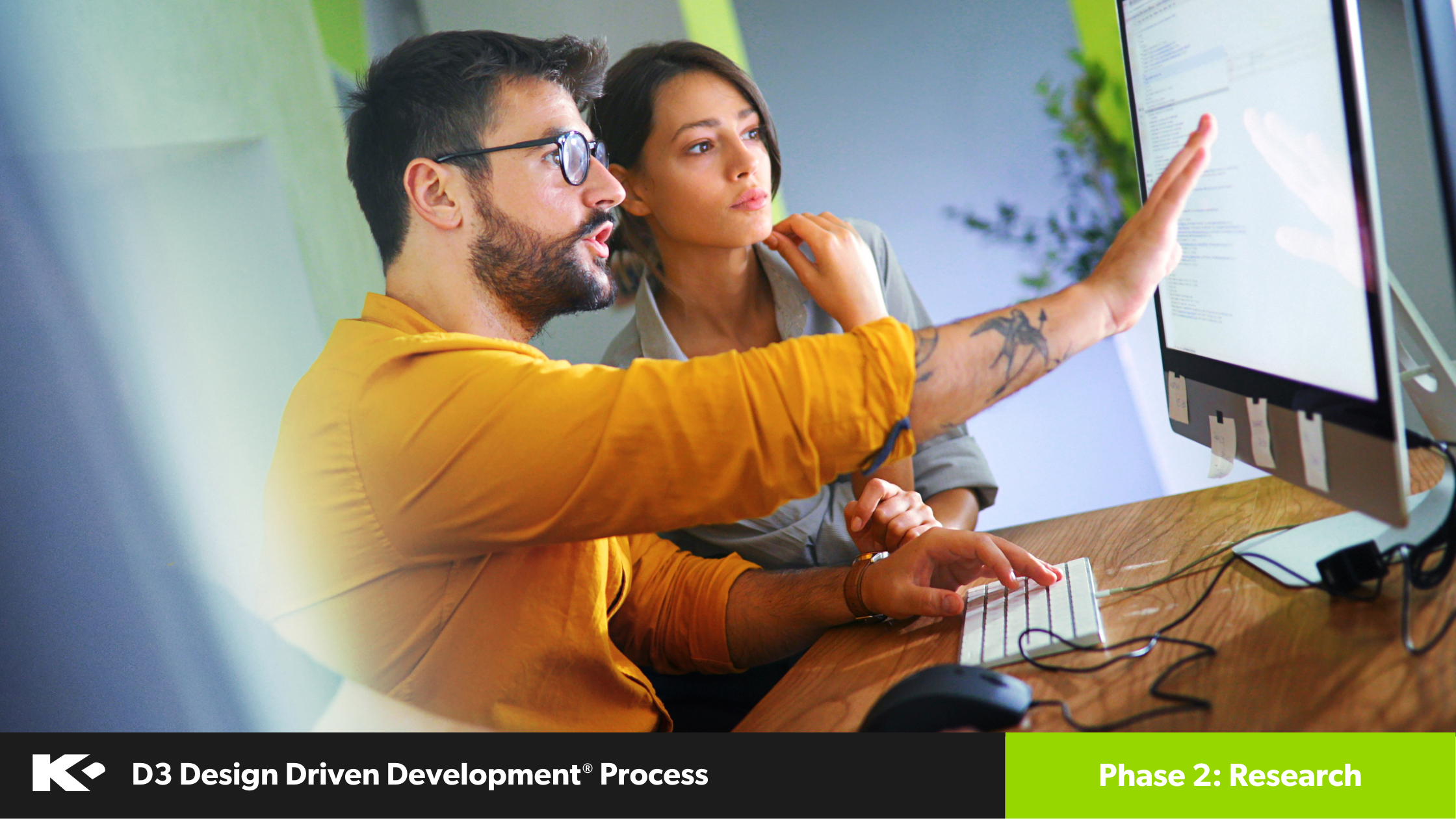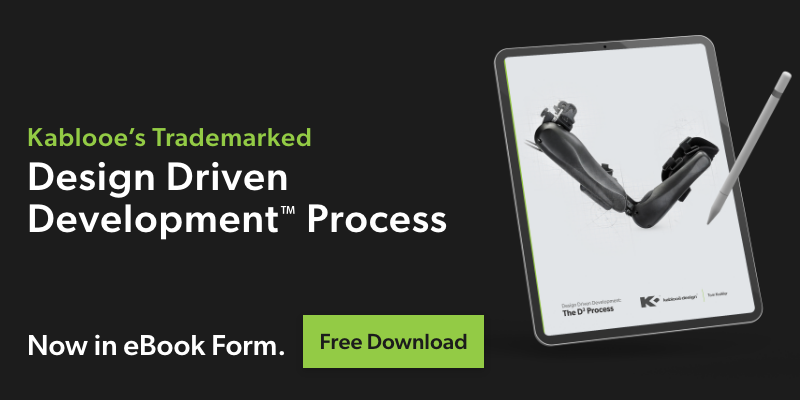Your 9-Step Guide to Product Development Research

Are you interested in developing a new product? Whether you’re a startup or an established company, product development research is an essential aspect of any project. That’s because it involves investigating your target market, understanding the competitive landscape, and evaluating the viability of your ideas—all crucial factors in a successful product launch.
In our previous post, we broke down the five steps of product evaluation. In this article, we’ll explore the 9-step product research path we developed as phase two of our trademarked Design Driven Development (D³) process. This comprehensive framework will guide you through the product development research process, helping you create innovative and successful products that meet the needs of your target audience and are viable in the market.
So, let’s dive in and discover how you can develop winning products through effective product development and market research!
How To Complete New Product Development Research: The 9-Step Path
In this product research and development phase, your legal, engineering, and marketing teams will work hand in hand to support the design team in a 9-fold research path. These nine steps include patent searching, developing a competitive landscape, ethnographic research, human factors investigation, demographic studies, early requirements formulation, limitation evaluation, criteria list development, and finally, making a go or no-go decision.
In this guide, we’ll explore each of these steps in detail, the key decisions to be made along the way, and the “phase gates” you need to achieve to move on to the next stage of development. Let’s begin.
1. Search for Existing Patents
The first step in the product research and development process is patent searching, where you dive deeper into the preliminary groundwork that was laid in the previous evaluation phase of the D³ Process. Patent searching is critical as it helps companies avoid infringing on existing patents and can help identify areas where there is room for innovation. The goal here is to look for patents on similar or otherwise related products that could spurn new development ideas, as well as patented ideas that may already provide product solutions for the market.
In this step, your cross-functional team will be developing an opinion on the best route to move forward. Depending on the patents you discover, you have three options:
- Design around existing patents
- License a current idea(s)
- Go off in a new direction
2. Develop a Competitive Landscape
Once patent searching is complete, the next step is to develop a complete competitive landscape. Work should have already been started on this in the evaluation and assessment phase, so this is the time to plumb the depths of the market to illustrate the potential difficulty of the competition and reveal where the opportunity gaps lie.
This involves researching existing products in the market and identifying their strengths and weaknesses. Companies can use this information to identify areas where their product can stand out in the market and to develop a unique selling proposition (USP).
3. Conduct Ethnographic Research
Ethnographic research involves observing and interviewing potential users in their natural environment. This type of research is essential as it allows companies to gain insights into how their target audience uses products, what their pain points are, and what they are looking for in a new product.
Whether it is the beginning of your official Human Factors Engineering (HFE) plan, or just an initial investigation to help inform your design decisions, this is an extremely valuable step to take. Ethnographic research can help companies develop products that fully meet the needs of their target audience and begin to test their product concept.
User research helps to understand who the potential users are, and what their needs might be. This work is best done by the design and/or HFE team with the help of marketing. Included in this endeavor are the following activities:
- Observational studies of users in action with predicate devices as well as new prototypes.
- Interviews of users and other key people
- Self-experience with the designers in a real setting
- Q & A sessions and surveys for key stakeholders and users
- Researching blogs and other online industry and academic forums
4. Investigate Human Factors
Further human factors investigation involves evaluating how users interact with products. This includes evaluating factors such as ergonomics, usability, and user experience. This type of research is critical as it helps companies develop products that are intuitive and easy to use by identifying and eliminating use risks and hazards.
The design team should assist the HFE team to research human factors data to develop relevant constraints to the potential product through the investigation of human interactive elements and physical human needs. This data helps to provide a logical framework within which new ideas can evolve.
5. Conduct Demographic Studies
Demographic studies involve researching the characteristics of the target audience. This includes factors such as age, gender, income, and education. Demographic studies can help companies develop products that are tailored to the needs of their target audience.
In this research phase, the marketing department should also put together a demographic profile of the users in the product opportunity space. This data will break down groups of people into subgroups according to their shared characteristics.
6. Formulate Early Requirements
Early requirements formulation involves developing a list of necessities for the new product. This list should be based on the insights gained from the previous steps in the research process. Early requirements formulation is critical as it helps ensure that the product meets the needs of the target audience.
The design team will then correlate important demographic data with potential design requirements. This data, along with all information gained from all the research steps mentioned above, will be the framework to create a preliminary list of technical and design requirements. These requirements are then turned into a preliminary product requirements document (PRD) with the collaboration of cross-functional management, marketing, engineering, regulatory, and design teams.
7. Evaluate All Possible Limitations
Limitation evaluation involves the thorough analysis of factors such as cost, feasibility, and technical limitations. These limitations should include restrictions imposed by the client, manufacturing constraints, regulatory and reimbursement issues, and potential user and market acceptance hurdles.
Findings from this work can help the PRD be pointed at removing your end users’ barriers to adoption. Limitation evaluation is critical as it helps companies determine if their product is viable and if it can be successfully brought to market.
8. Develop a Criteria List
Near the end of the research phase, the design team will put together a comprehensive design criteria list that condenses all the information learned from the research—and from the requirements and limitations lists—into tangible product criteria which will be used to guide the product development research effort. From a user-centric design standpoint, this list will make up the user interface requirements portion of your PRD, as well as contribute to the product requirements portion as well.
This criteria list will require the acceptance and signatures of the entire cross-functional management team, as well as any other key stakeholders within the customer’s organization. It will then be used to help customize the strategic design plan for the rest of the development process.
9. Make a “Go/No-Go” Decision
The final step in the product research and development process is making what we like to call a “go or no-go” decision. This involves evaluating all of the information gathered during the research process and determining if the product is indeed viable. If it is, you can move forward with product development. If it’s not, your company may need to go back to the drawing board and start product development research all over again.
Go or No-Go Decision Factors:
- Is the value proposition viable & sustainable?
- Are the product risks acceptable?
- Could a preliminary list of design inputs be formed at this point?
- Is there a confirmed criteria list that is accepted and signed off on by all key stakeholders?
Design Your Product For Success With Kablooe
The key to successful product development research is to remain open-minded, flexible, and adaptable. Companies must be willing to listen to their target audience and adjust their ideas accordingly. They must also be willing to accept feedback and make changes to their product if necessary.
By following our 9-step product research path, you’ll significantly increase your chances of creating a viable final product that resonates with your target market and succeeds in today’s competitive landscape. To learn about the next phase in our trademarked D³ Process, download Kablooe’s FREE eBook today.

